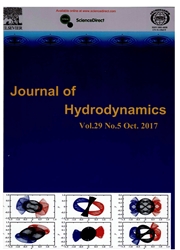

 中文摘要:
中文摘要:
The perforated breakwater is an environmentally friendly coastal structure,and dissolved oxygen concentration levels are an important index to denote water quality.In this paper,oxygen transport experiments with regular waves through a vertical perforated breakwater were conducted.The oxygen scavenger method was used to reduce the dissolved oxygen concentration of inner water body with the chemicals Na2SO3 and Co Cl2.The dissolved oxygen concentration and wave parameters of 36 experimental scenarios were measured with different perforated arrangements and wave conditions.It was found that the oxygen transfer coefficient through wave surface,K1a1,is much lower than the oxygen transport coefficient through the perforated breakwater,K2a2.If the effect of K1a1 is not considered,the dissolved oxygen concentration computation for inner water body will not be greatly affected.Considering the effect of a permeable area ratio α,relative location parameter of perforations δ and wave period T,the aforementioned data of 30 experimental scenarios,the dimensional analysis and the least squares method were used to derive an equation of K2a2(K2a2=0.0042α0.5δ0.2T-1).It was validated with 6 other experimental scenarios data,which indicates an approximate agreement.Therefore,this equation can be used to compute the DO concentration caused by the water transport through perforated breakwater.
 英文摘要:
英文摘要:
The perforated breakwater is an environmentally friendly coastal structure, and dissolved oxygen concentration levels are an important index to denote water quality. In this paper, oxygen transport experiments with regular waves through a vertical perforated breakwater were conducted. The oxygen scavenger method was used to reduce the dissolved oxygen concentration of inner water body with the chemicals Na2SO3 and COC12. The dissolved oxygen concentration and wave parameters of 36 experimental scenarios were measured with different perforated arrangements and wave conditions. It was found that the oxygen transfer coefficient through wave surface, K1α1, is much lower than the oxygen transport coefficient through the perforated breakwater, K2α2. If the effect of K1α1 is not considered, the dissolved oxygen concentration computation for inner water body will not be greatly affected. Considering the effect of a permeable area ratio a, relative location parameter of perforations 6 and wave period T, the aforementioned data of 30 experimental scenarios, the dimensional analysis and the least squares method were used to derive an equation of K2α2 (K2α2=0.0042aσ5 6δ2T1). It was validated with 6 other experimental scenarios data, which indicates an approximate agreement. Therefore, this equation can be used to compute the DO concentration caused by the water transport through perforated breakwater.
 同期刊论文项目
同期刊论文项目
 同项目期刊论文
同项目期刊论文
 Oxygen transfer characteristic of water and bubbles mixture pipe flow through two sudden contraction
Oxygen transfer characteristic of water and bubbles mixture pipe flow through two sudden contraction 期刊信息
期刊信息
